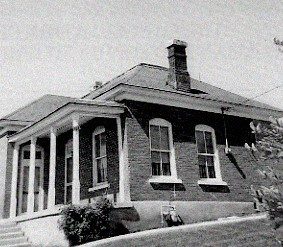In 1854, Judson moved his family to Bountiful. They probably lived temporarily with Judge Holbrook’s family while their first permanent residence was being built. By that time, their children numbered four—Nancy Jane, born 4 February 1848; Judson Adonirum, born February 25, 1850; Joseph Holbrook, born July 17, 1851; and Jaren, born April 18, 1853. We should remember that Judson had taken a second wife—Mary Reeves Coleman—while living in Tooele in 1852. There is no indication that she moved with him to Bountiful. From the preceding quotes regarding the Indians and the stealing of his oxen, etc., plus the fact that Joseph Holbrook had settled his own family in Bountiful, it was natural for Judson and his young bride to want to be close to the Holbrooks. As we have seen, from the time that Judson married Sarah Lucretia until they left for Tooele in 1849, Judson and his father-in-law “had worked together as one man.” Sarah Lucretia was now twenty-two years of age. She had been married nearly nine years, had given birth to five children and was probably feeling a strong sense of separation from her parents and siblings as well as a very natural desire to enjoy the proximity of grandparents for her little ones. In addition, Judge Joseph Holbrook and Joseph S. Holbrook had decided to build a sawmill in Holbrook Canyon (Bountiful)—which naturally could benefit from the talents and energy of the much younger and experienced Judson. While Judson did not relocate until 1854, he participated in the construction of this mill in 1852. It was the first of what was to be four or perhaps five different sawmills that he built in Bountiful and East Canyon. The second sawmill was located near the family home, on the bench at the mouth of Ward’s Canyon.
One of the first homes built in Bountiful by Judson and Sarah Lucretia was a brick structure, located at 264 north 100 East. (The home still occupies the lot at 264 North 100 East, though it has been remodeled.) According to records of the Tolman Family Genealogical Organization, this home was constructed between March 2, 1867 and February 8, 1872. Sarah Lucretia died in childbirth at this home on February 4, 1869. She suffered from jaundice and protracted labor. Her infant daughter, who died at the same time, was buried on her mother’s arm. In that year, Judson married Zibiah Jane Stoker, the daughter of Bishop John Stoker, and the young woman who had cared for Sarah Lucretia during her illness. That was also the year in which his sealing to Sophia Merrell was cancelled. Sophia Merrell’s residence was a stone and mortar house on the east bench of Bountiful, situated between the red brick home that Judson later built for Zibiah Jane Stoker and that of his son Jaren. He and Jane lived at 264 North 100 East until Judson completed construction of the larger, brick structure at 1351 East Skyline Drive (just above Tolman Road) in approximately 1894.
In the company of Joseph Holbrook and Heber C. Kimball, Judson Tolman built a toll road into Holbrook Canyon. Much of the timber for the building of the Bountiful Tabernacle was harvested from this Canyon, which had been so named because it was owned by Judson’s father-in-law, Judge Joseph Holbrook. On the south side of the canyon, approximately three quarters of a mile above the road that, in those days, was known as “Tolman Road” (Consult the map of Bountiful that was recreated for the Centennial Celebration in 1992. The map is available at the Bountiful Museum, 845 South Main Street.) and is now 1300 East, is located Meeting House Hollow, so named because it held a particularly beautiful stand of pine and fir trees that were harvested for the Bountiful Tabernacle.
On February 11, 1857, ground was dedicated by Lorenzo Snow, under the direction of President Brigham Young for a tabernacle to be constructed in Bountiful. Construction began immediately under the direction of Bishop John Stoker, who would become Judson Tolman’s father-in-law in 1869. The first load of rock that was hauled for the foundation of the tabernacle was hauled by Mariner W. Merrill and James I. Atkinson. According to Patriarch Israel Call, “rock was thick all over the place and was very plentiful, the lime that the moter (sic) was made from was burned in the kilns in the hollow of Barton Creek… Most of the timber was taken from Holbrook Canyon. The timber in the roof is not put together with nails… The frame work of the roof was made of red pine timber, it was the best we had in this part of the country.” (Consult the map of Bountiful that was recreated for the Centennial Celebration in 1992. (The map is available at the Bountiful Museum, 845 South Main Street.) Six years later, on March 14 and 15, 1863, the tabernacle was dedicated. It was a grand, two-day event—the largest ever recorded to that date in the city of Bountiful. A partial list of speakers or participants in the dedicatory serviced included Brigham Young; Heber C. Kimball, who gave the dedicatory prayer; Wilford Woodruff; Joseph Young; Daniel H. Wells; John Taylor; Orson Pratt; Franklin D. Richards and George Albert Smith. It is said to be the oldest meetinghouse in the Church that has been in continual use. (Leslie T. Foy, The City Bountiful. Utah, Horizon Publishers, 1975, pages 104-106.)
Frank Ashdown describes yet another reason why the families who lived on the bench were fond of the canyons east of Bountiful. “We used to go up in this canyon (Holbrook’s Canyon) and shoot wild chickens and put them in barrels in salt to eat during the winter. (The “wild chickens referred to here are of three varieties that inhabit the mountains east of Bountiful—ruffed grouse, blue grouse and Franklin’s Spruce Grouse. They are there even today.) They…used to salt chickens down and it was a change from pork. We didn’t have much beef, but a lot of pork. We used to butcher our pigs in the fall. Thanksgiving was usually the date we’d figure on. We had no refrigeration. We would render the lard and put it in a flour sack that made a long thing about as big as baloney.” (Oral interview with Frank D. Ashdown, conducted February 23, 1980 by Don LeFevre. A copy of the transcription of this interview is in the possession of Dennis Tolman. Note: Frank Ashdown’s property is located on 5th south and 10th East, on the north side of Barton Creek, just below Davis Boulevard. His memories of Bountiful from the turn of the century until his death, not long after this interview, are especially helpful in understanding the neighborhood, the citizens and the historical highlights.)
He continues with his description of life on the Bountiful bench—his residence being located at 500 South (Moss Hill) just below the current Davis Boulevard: “When we went sleigh riding or went downtown (in the winter) sometimes we’d heat those bricks up to put them down under the quilt that we’d wrap our feet in. It was slow going with the horse and wagon. In the wintertime the hill was slick and you’d have a time pulling. Sometimes we’d have to get out and push so the horse could make it… One good neighbor up there, Mr. Tolman, had a V-type drag, a wedge-shaped plank that he would pull down the road and smooth the snow so that the team could get up and down and so us kids could get to school, but that was about the only snow removal equipment there was in the town. We were always glad when we could get in the path the wagons had made and ride our sleighs down.” (Oral interview with Frank D. Ashdown, conducted February 23, 1980 by Don LeFevre.)
In the map of Bountiful that was re-published for the centennial celebration of 1992, the road that is today known as 1300 East, running between 6th South and 250 North, was known as Tolman Road. Judson Tolman’s residences were located at approximately 1351 East 250 North (Skyline Drive). Today, there are two large pine trees on the south side of a brick home that occupies the lot where Judson Tolman’s brick home stood. Across the street to the south was a concrete home (see photo) that was the residence of Sophia Merrell Tolman and her four children. Jaren Tolman’s home stood immediately south of Sophia Merrell’s home. The ice pond was located below 13th East on 250 North. Today the ice pond location is a parking lot, just west of 1300 East, and east of the city baseball field on the south side of Tolman Park. The ice house was constructed to the west of the pond. It was a structure of sufficient size for a team of horses to be used to haul large blocks of ice inside, with sufficient room for the team to be turned around and exit by the same doorway they entered. The blocks of ice were stored in thick layers of saw dust from the Tolman sawmills.
Judson and his boys ran sawmills in both Ward’s Canyon, on Stone Creek, and Holbrook’s Canyon, on Barton Creek. Lucile Tolman Knighton remembers the sawmill in Ward’s Canyon being located immediately north of Judson’s residence, at the base of a small cliff through which the stream passed. A path ran from the house down to the stream, where the family frequently went for bathing during warm weather. She also recalls the irrigation ditch which ran from east to west, just south of the brick home. “Aunt Jane would go out there with a bucket to fetch her water for cooking and washing. That ditch was also the source of water for the ice pond, which would have stood at least twenty or more feet above the level of the creek bed at that time.” The water from Stone Creek originated in a diversion culvert on the stream, south of the “B” on the mountain side. Lucile tells us that 1300 East did not cross Stone Creek until much later. Instead, at Judson’s property, it turned westward, and led down the mountain to the current site of Hannah Holbrook Elementary School. It was known to Bountiful residents as the “Old Rocky Road.”
(Contributed by the Thomas Tolman Family Organization. Excerpt from Judson Tolman: Pioneer, Lumberman, Patriarch by E. Dennis Tolman, Second Edition, 2004, pages 48-51.)


